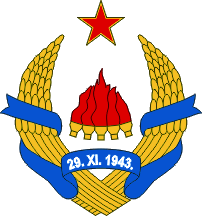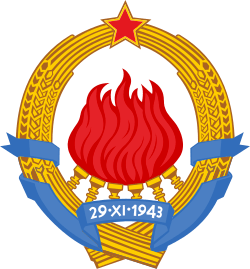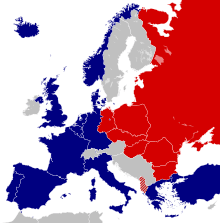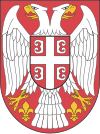Democratic Federal Yugoslavia
Democratic Federal Yugoslavia Demokratska Federativna Jugoslavija Демократска Федеративна Југославија Demokratična federativna Jugoslavija | |
|---|---|
| 1943–1945 | |
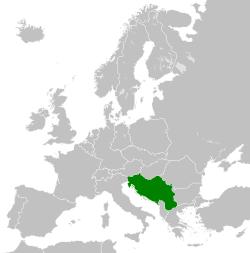 Democratic Federal Yugoslavia in 1945 | |
| Capital and largest city | Belgrade |
| Official languages |
Serbian Croatian Slovene Macedonian[1] |
| Common languages | Yugoslav[2] |
| Official script | Cyrillic • Latin |
| Demonym |
Yugoslav Yugoslavian |
| Government |
Federal state –National Committee (1943–45) –Constitutional monarchy (1945) |
| Chairman of the Presidium of the AVNOJ | |
• 1943–45 | Ivan Ribar |
| King | |
• 1945 | Peter II |
| Prime Minister | |
• 1943–45 | Josip Broz Tito |
| Legislature | Temporary National Assembly |
| Historical era | World War II |
| 29 November 1943 | |
| 16 June 1944 | |
| 7 March 1945 | |
| 24 October 1945 | |
| 11 November 1945 | |
• Abolition of the monarchy | 29 November 1945 |
| Area | |
• Total | 255,804 km2 (98,766 sq mi) |
| Population | |
• 1945 estimate | circa 14,000,000 |
| Currency | Yugoslav dinar (YUD) |
| Time zone | UTC+2 (Central European Time (CET)) |
| Driving side | right |
| Calling code | 38 |
Democratic Federal Yugoslavia (or Democratic Federative Yugoslavia; DF Yugoslavia or DFY) was a provisional state established during World War II on 29 November 1943 through the Second Session of the Anti-Fascist Council for the National Liberation of Yugoslavia (ANOJ). The National Committee for the Liberation of Yugoslavia (NKOJ) was its original executive body. Throughout its existence it was governed by Marshal Josip Broz Tito as prime minister.
It was recognized by the Allies at the Tehran Conference, along with the AVNOJ as its deliberative body. The Yugoslav government-in-exile of King Peter II in London, partly due to pressure from the United Kingdom,[3] recognized the AVNOJ government with the Treaty of Vis, signed on 16 June 1944 between the prime minister of the government-in-exile, Ivan Šubašić, and Tito.[4] With the Treaty of Vis the government-in-exile and the NKOJ agreed to merge into a provisional government as soon as possible. The form of the new government was agreed upon in a second Šubašić–Tito agreement signed on 1 November 1944 in the recently liberated Yugoslav capitol of Belgrade. DF Yugoslavia became one of the founding members of the United Nations upon the signing of the United Nations Charter in October 1945.
The state was formed to unite the Yugoslav resistance movement to the occupation of Yugoslavia by the Axis powers. The agreement left the issue of whether the state would be a monarchy or a republic undecided until after the war and the position of head of state was vacant. After the merge of the governments, Josip Broz Tito became Prime Minister and Ivan Šubašić became foreign minister.
History
The Second Session of the AVNOJ, held in Jajce in November 1943, opened with a declaration that read in part:
- That the Anti-Fascist Council of National Liberation of Yugoslavia be constituted as the supreme legislative and executive representative body of Yugoslavia as the supreme representative of the sovereignty of the peoples and of the State of Yugoslavia as a whole, and that a National Committee of Liberation of Yugoslavia be established as an organ with all of the features of a national government, through which the Anti-Fascist Council of National Liberation of Yugoslavia will realize its executive function.
- That the traitorous "government" in exile be deprived of all rights as the legal government of Yugoslavia, particularly of the right to represent the peoples of Yugoslavia anywhere or before anyone.
- That all international treaties and obligations concluded abroad in the name of Yugoslavia by the "government" in exile be reviewed with a view to their invalidation or renewal or approval, and that all international treaties and obligations which the so-called "government" in exile may eventually conclude abroad in the future receive no recognition.
- That Yugoslavia be established on a democratic federal principle as a state of equal peoples.[5]
The AVNOJ then issued six decrees and the Presidium of the AVNOJ, which continued its functions when it was not in session, followed with four decisions. Together these comprised the constitution of the new state taking shape in Yugoslavia. On 30 November the Presidium gave Tito the rank of Marshal of Yugoslavia and appointed him president of the government (or acting prime minister) and Minister of National Defence. Three vice presidents and thirteen other ministers were appointed to the NKOJ.[5]
The name "Democratic Federative Yugoslavia" was officially adopted on 17 February 1944. On the same day they adopted the five-torch emblem of Yugoslavia.[6]
Government
Its legislature, after November 1944, was the Provisional Assembly.[7] The Tito-Subasic agreement of 1944 declared that the state was a pluralist democracy that guaranteed: democratic liberties; personal freedom; freedom of speech, assembly, and religion; and a free press.[8] However by January 1945 Tito had shifted the emphasis of his government away from emphasis on pluralist democracy, claiming that though he accepted democracy, he claimed there was no "need" for multiple parties, as he claimed that multiple parties were unecessarily divisive in the midst of Yugoslavia's war effort and that the People's Front represented all the Yugoslav people.[9] The People's Front coalition, headed by the Communist Party of Yugoslavia and its general secretary Marshal Josip Broz Tito, was a major movement within the government. Other political movements that joined the government included the "Napred" movement represented by Milivoje Marković.[10]
Democratic Federal Yugoslavia was ruled by Temporary Government consisting mostly of Unitary National Liberation Front members and small number of other political parties from former Kingdom of Yugoslavia. President of the Government was Josip Broz Tito. Communists held 22 minister positions, including Finances, Internal Affairs, Justice, Transport and others. Ivan Šubašić, from Croatian Peasant Party and former ban of Croatian Banovina, was minister of Foreign Affairs, while Milan Grol, from Democratic Party, was Deputy Prime Minister. Many non-communist government members resigned due to disagreement with the new policy.[11]
Administrative Divisions
Democratic Federal Yugoslavia consisted of 6 republic and 2 autonomous regions
- Federal State of Croatia
- Federal State of Bosnia and Herzegovina
- Federal State of Slovenia
- Federal State of Montenegro
- Democratic Federal Macedonia

References
- ↑ These were the languages specified for the Emblem of Yugoslavia on 17 February 1944.
- ↑ Tomasz Kamusella. The Politics of Language and Nationalism in Modern Central Europe. Palgrave Macmillan, 2008. Pp. 228, 297.
- ↑ Walter R. Roberts. Tito, Mihailović, and the allies, 1941-1945. Duke University Press, 1987. Pp. 288.
- ↑ Walter R. Roberts. Tito, Mihailović, and the allies, 1941-1945. Duke University Press, 1987. Pp. 288.
- 1 2 Michael Boro Petrovich, "The Central Government of Yugoslavia", Political Science Quarterly, Vol. 62, No. 4 (1947), pp. 504–30.
- ↑ Marko Attila Hoare, The Bosnian Muslims in the Second World War: A History (Oxford University Press, 2013), p. 200.
- ↑ Vojislav Koštunica, Kosta Čavoški. Party pluralism or monism: social movements and the political system in Yugoslavia, 1944-1949. East European Monographs, 1985. Pp. 22.
- ↑ Sabrina P. Ramet. The three Yugoslavias: state-building and legitimation, 1918-2005. Bloomington, Indiana, USA: Indiana University Press. Pp. 167-168.
- ↑ Sabrina P. Ramet. The three Yugoslavias: state-building and legitimation, 1918-2005. Bloomington, Indiana, USA: Indiana University Press. Pp. 167-168.
- ↑ Vojislav Koštunica, Kosta Čavoški. Party pluralism or monism: social movements and the political system in Yugoslavia, 1944-1949. East European Monographs, 1985. Pp. 22.
- ↑ http://adattar.vmmi.org/fejezetek/2078/09_prva_decenija_titove_jugoslavije.pdf
| Pre–1918 | 1918–1929 | 1929–1945 | 1941–1945 | 1945–1946 | 1946–1963 | 1963–1992 | 1992–2003 | 2003–2006 | 2006–2008 | 2008– | |
| Slovenia | See also Kingdom of Croatia-Slavonia 1868–1918 Kingdom of Dalmatia 1815–1918 Condominium of Bosnia and Herzegovina 1878–1918 |
See also Banat, Bačka and Baranja 1918–1919 Italian province of Zadar 1920–1947 |
Annexed bya Fascist Italy and Nazi Germany |
Democratic Federal Yugoslavia 1945–1946 Federal People's Republic of Yugoslavia 1946–1963 Socialist Federal Republic of Yugoslavia 1963–1992 Consisted of the Socialist Republics of Serbia (1945–1992) (included the autonomous provinces of Vojvodina and Kosovo) |
Ten-Day War | ||||||
| Dalmatia | Puppet state of Nazi Germany. Parts annexed by Fascist Italy. Međimurje and Baranja annexed by Hungary. |
Croatian War of Independence | |||||||||
| Slavonia | |||||||||||
| Croatia | |||||||||||
| Bosnia | Bosnian War Consists of the Federation of Bosnia and Herzegovina (1995–present), Republika Srpska (1995–present) and Brčko District (2000–present). | ||||||||||
| Herzegovina | |||||||||||
| Vojvodina | Part of the Délvidék region of Hungary | Autonomous Banatd (part of the German Territory of the Military Commander in Serbia) |
Federal Republic of Yugoslavia | State Union of Serbia and Montenegro | Includes the autonomous province of Vojvodina | ||||||
| Serbia | Kingdom of Serbia 1882–1918 |
Territory of the Military Commander in Serbia 1941–1944 e | |||||||||
| Kosovo | Part of the Kingdom of Serbia 1912–1918 |
Mostly annexed by Albania 1941–1944 along with western Macedonia and south-eastern Montenegro |
|||||||||
| Metohija | Kingdom of Montenegro 1910–1918 Metohija controlled by Austria-Hungary 1915–1918 | ||||||||||
| Montenegro | Protectorate of Montenegrof 1941–1944 |
||||||||||
| Macedonia | Part of the Kingdom of Serbia 1912–1918 |
Annexed by the Kingdom of Bulgaria 1941–1944 |
|||||||||
|
| ||||||||||
.svg.png)
